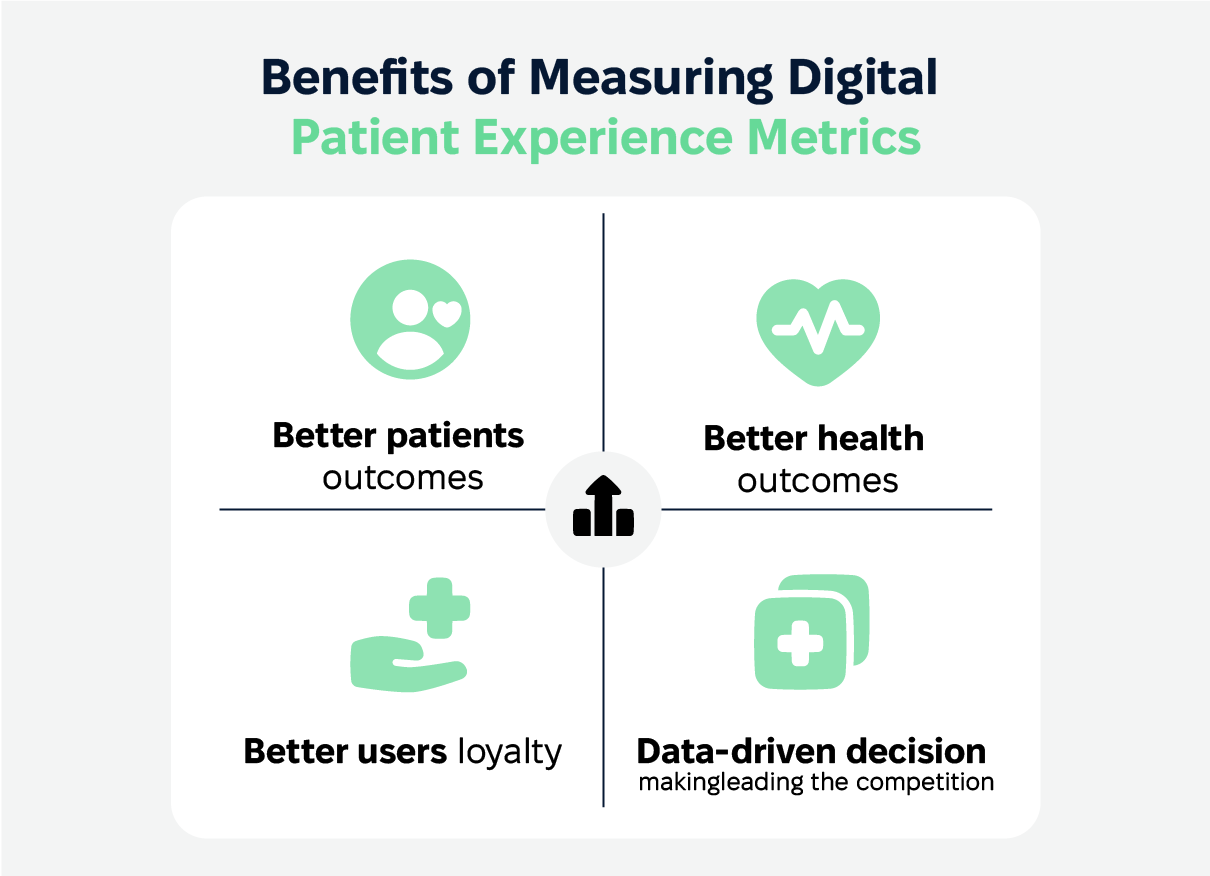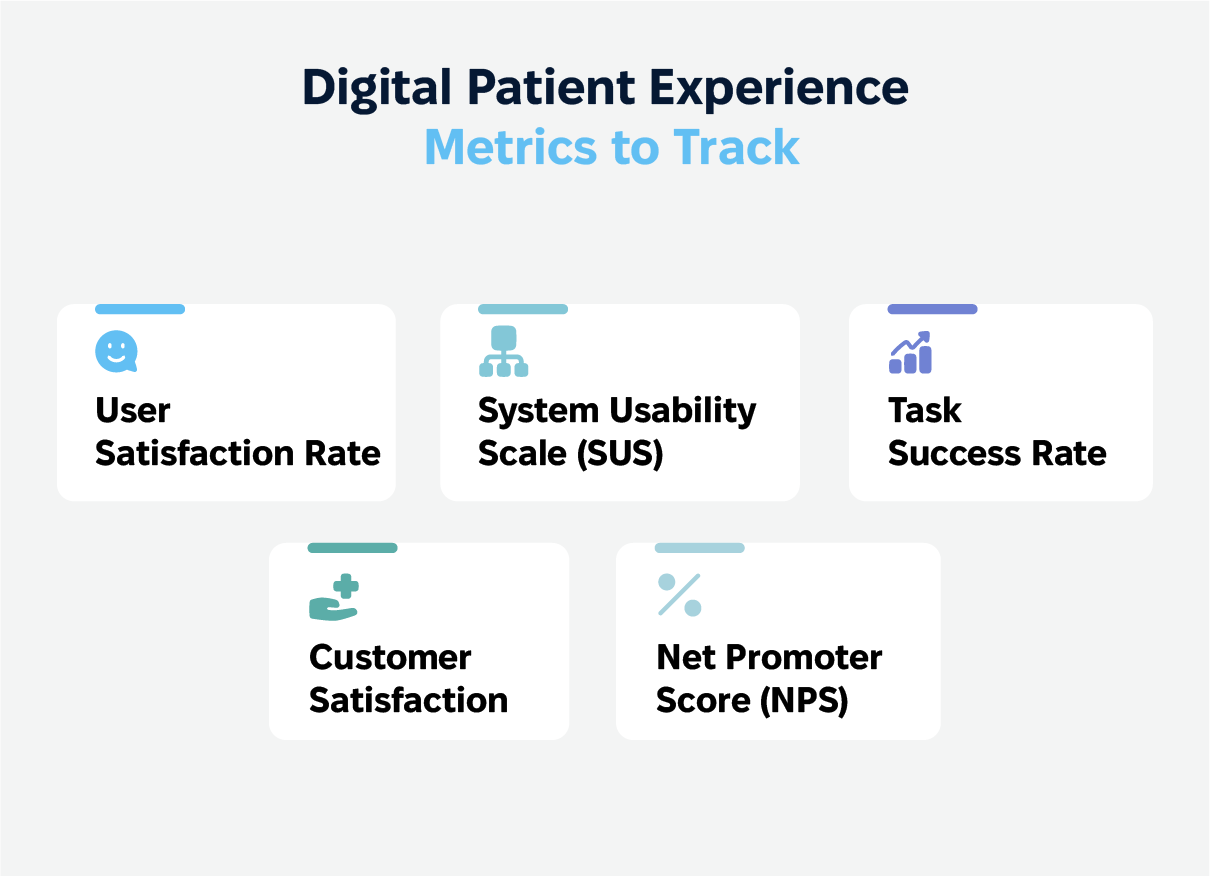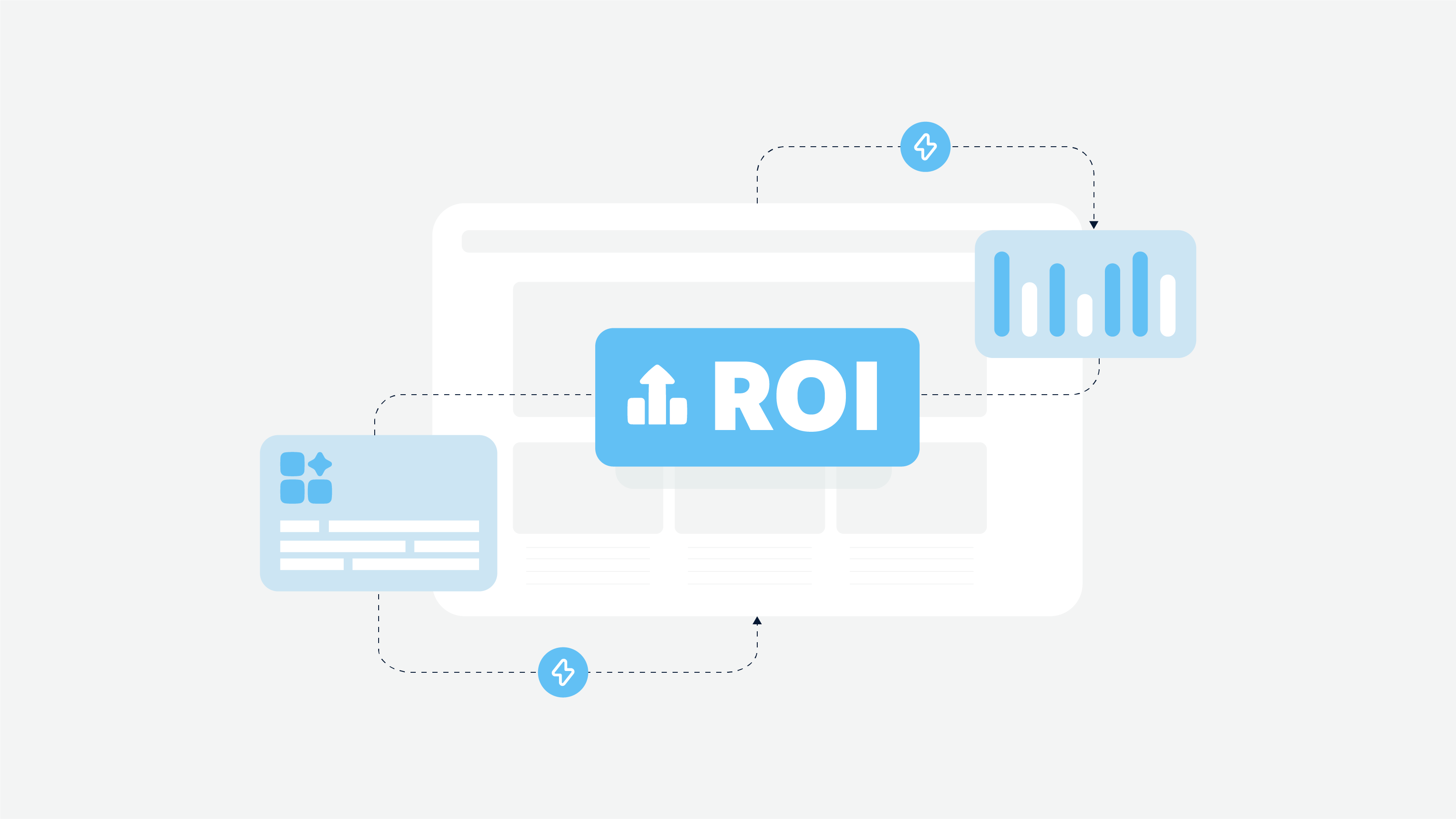According to Forrester research, every $1 invested in UX results in a return of $100, which means ROI = 9,900%. And 80% of people are willing to pay more for a better digital experience. In any industry, but in healthcare especially, UX makes a world of difference. But how to boost it? And what can guide you through this journey?
In our new blog post, we’ll talk about digital patient experience metrics and ways to measure them. We’ll also discover best practices and expert tips in this way.
Why Measure Digital Patient Experience?
There are three main reasons why you should measure user experience even if you’ve used web content accessibility guidelines.
Getting a handle on patient interactions
Measuring these metrics is like having a GPS for understanding how patients interact with digital platforms. It shows healthcare providers what’s clicking with users and how they can use it in the future. By diving into this data, you can fine-tune your platform to make it much more patient-friendly.
After all, a little insight can turn a bumpy road into a smooth ride. For instance, if a patient repeatedly lands on the FAQ page but still contacts support, it might be a sign the answers aren’t clear or easy to find.
Reading between the lines of patient behavior
Digital metrics spill the beans on user expectations, preferences, habits, and headaches. They flag common struggles like confusing navigation or not knowing where to click next. So providers can tackle those issues. Think of it as spotting a squeaky wheel and giving it the grease it needs.
Here is a very simple example. If many patients abandon the appointment booking process halfway through, it’s a red flag to simplify those steps.
A treasure trove of optimization opportunities
You need to collect data from these metrics because this is the best guideline for making improvements. Whether it’s streamlining appointment booking or improving the time users spend using your app, small changes can pack a big punch. You can’t fix what you don’t measure. How actively users interact with your features? How many users abandoned the appointment form?
Keeping an eye on these metrics ensures digital tools stay relevant and effective. For instance, if analytics show patients rarely click on a health tip feature, it might mean the placement or topic isn’t grabbing attention—it’s time for a redesign or rethink.
When you measure what matters, you’ll not only help patients find their way but also build a platform that keeps them coming back.
Benefits of Tracking Digital Patient Experience Metrics

Here are some other benefits of tracking user interactions and other metrics.
Happier patients, better outcomes
When patients find digital tools easy to use, they’re more likely to engage and trust their healthcare provider. Whether it’s booking appointments or accessing test results, a seamless experience makes all the difference. It improves user retention rate and human-computer interaction. A patient who can easily refill prescriptions online is less likely to skip doses, boosting their health outcomes.
Boosted health outcomes
A better digital experience helps patients make sense of their health info, improving literacy and compliance. When it’s easy to understand and follow medical advice, patients are more likely to stick to their treatment plans.
Loyalty that lasts
Satisfied patients are like loyal customers; they stick around. If you can improve your usability metrics, patients will keep coming back instead of shopping around.
Make smarter decisions with data
Quantitative metrics are like the breadcrumbs that lead to better strategies. By following the numbers, providers can pinpoint what’s working and fix what’s not. For instance, if data shows most users abandon forms after page three, it’s time to simplify.
Lead the competition
In a world where patients have options, a standout digital experience is your ace in the hole. If your platform is easy, intuitive, and engaging, you’re already miles ahead.
The bottom line? Tracking these metrics isn’t just about numbers. If you measure task success rate or attitudinal UX KPIs, you create a digital experience that keeps patients coming back for more.
Understanding UX Metrics and KPIs
UX metrics and KPIs (Key Performance Indicators) are like two sides of the same coin, working together to give a clear picture of how users interact with digital platforms and how those interactions stack up against your goals. UX metrics focus on the human side—how users feel and think when they’re using your tools. Are they satisfied, frustrated, or confused? These insights help you understand what’s hitting the mark and what’s missing it.
KPIs, on the flip side, are all about the numbers. They track progress toward specific targets, like boosting engagement or cutting down on no-shows. When you combine the emotional and cognitive insights from UX metrics with the hard data from KPIs, you get a full view of what’s working and where there’s room for improvement. This combo helps you make smart, impactful changes that truly enhance the digital experience.
Key Differences Between UX Metrics and KPIs
The main difference between UX metrics and KPIs lies in their focus.
UX metrics zoom in on user behaviour and attitudes — things like how easy a platform is to use or how satisfied patients feel.
KPIs, on the other hand, are tied to specific goals and objectives, tracking progress in areas like appointment completion rates or portal adoption.
UX metrics tend to give you qualitative insights, like why users are frustrated or what features they love. KPIs deliver the numbers and numerical data that show how well your platform is performing against set targets.
Together, they serve different but complementary purposes. UX metrics help healthcare providers understand the actual user experience, giving context to how patients interact with digital tools. KPIs measure whether those tools are delivering on broader performance goals, offering a more results-focused perspective.
Book a free consultation and find a way to boost your user satisfaction!
Top 5 Digital Patient Experience Metrics to Track

1. User Satisfaction
User satisfaction tells you how patients feel about their experience with your digital platform. It’s usually measured through
surveys,
feedback forms,
Net Promoter Score (NPS).
It helps you understand how likely patients are to recommend your services. These tools give you a clear picture of patient satisfaction and loyalty, making it a key indicator of how good your digital patient experience really is.
Why user satisfaction is crucial
When patients are satisfied, they’re more likely to stick around. High satisfaction boosts patient retention and loyalty, making it easier to keep your users engaged. It also leads to better health outcomes, as happy patients are more likely to make the most of educational resources and follow their treatment plans. Plus, in today’s competitive healthcare market, a great digital experience can set you apart from the rest.
2. System Usability Scale (SUS)
The System Usability Scale (SUS) is a popular tool for measuring the usability of digital platforms, helping you assess how easy and effective the system is for users. It’s typically measured through surveys or feedback forms where patients rate their experience. This gives you a clear view of how accessible and user-friendly your platform really is.
Benefits of a high SUS Score
A high SUS score means your platform is user-friendly and easy to navigate, which is key to improving patient engagement and satisfaction. When the system is intuitive, patients are more likely to use it regularly, leading to better interactions and outcomes.
Plus, a high SUS score can help reduce errors by making the platform simpler to understand and navigate, ultimately improving health outcomes by supporting more accurate and efficient care.
Why SUS is crucial
Having a solid SUS score is essential because it shows that your platform is meeting the needs of your users. The easier and more enjoyable the platform is to use, the more likely patients are to engage with it, leading to greater patient retention, better outcomes, and a more seamless healthcare experience overall.
3. Task Success Rate
Task success rate obviously tells you what percentage of patients can complete task successfully
on your platform. This may be things like booking appointments, checking test results, or updating their info. This metric is a great indicator of how well your platform helps users achieve their goals and get things done without frustration. The higher the task success rate, the smoother and more effective the platform is.
How to improve the task success rate
Simplify navigation and user interface. To improve the task success rate, focus on making the platform easy to navigate with a simple, intuitive design.
Provide clear instructions and feedback. Clear instructions and real-time feedback also help guide users so they feel confident in what they’re doing.
Test and iterate digital patient experience platforms. It’s important to keep testing and iterating the platform to iron out any issues and ensure it meets patient needs at every turn.
Why task success rate is crucial
The task success rate is a big deal because it shows whether patients are able to get what they need from the platform. The easier it is for them to complete tasks, the more likely they are to engage with it and stick with it. Plus, a high task success rate helps reduce errors and supports better health outcomes, as patients can access the right info at the right time with fewer roadblocks.
4. Customer Satisfaction
This metric is all about understanding how happy patients are with their digital experience. It can be measured through tools like surveys, feedback forms, or the Customer Satisfaction Score (CSAT). These metrics give you clear insights into how satisfied patients are, which is a key indicator of how well your platform is meeting their needs.
Benefits of high customer satisfaction
When patients are satisfied, they’re more likely to stick with your services. High customer satisfaction boosts patient retention and loyalty, helping you build long-term relationships. It also contributes to better health outcomes, as happy patients are more likely to engage with educational content and follow their treatment plans. Plus, in today’s competitive healthcare environment, offering an outstanding digital experience gives you a big edge over the competition.
Why CSAT is crucial
Customer satisfaction is crucial because it reflects how well your platform is serving patients. The more satisfied they are, the more likely they are to use the platform regularly, leading to higher engagement and fewer errors. A high satisfaction rate also directly ties into better health outcomes, as patients are more informed, engaged, and compliant with their care.
5. Net Promoter Score (NPS)
Net Promoter Score (NPS) measures how likely patients are to recommend your digital platform to others. It’s a powerful tool for gauging patient loyalty and overall satisfaction. NPS provides practical insights into patient behavior and preferences, helping you understand not just how they feel about your service but also what drives their decisions. It’s a key indicator of the quality of your digital patient experience.
Importance of NPS in digital patient experience
High NPS scores mean you have a loyal, satisfied patient base. These patients are not only likely to continue using your services but also to recommend them to others, boosting patient acquisition. NPS also reveals deeper insights into patient preferences, allowing you to tailor your platform and services to better meet their needs, improving overall satisfaction and engagement.
Why NPS is crucial
NPS is crucial because it gives you a direct measure of patient loyalty and satisfaction. A high score indicates that your platform is resonating with users and providing a quality experience. This leads to stronger patient retention, more word-of-mouth referrals, and a greater understanding of patient behavior, allowing you to refine your platform for even better results.
Types of UX Metrics
Behavioral UX Metrics
Behavioral UX metrics track how patients actually use the platform, which is essential for usability testing. These metrics focus on things like what actions they take, how long they spend on tasks, and where they might get stuck. The insights help providers figure out what’s working well and where the platform can be tweaked for a smoother experience.
Time on Task
Time on task measures how long it takes for patients to complete specific tasks, like booking an appointment or checking test results. If it takes longer than expected, it might mean the platform is confusing or not intuitive enough. For example, if patients are taking forever to schedule an appointment, it could point to a complicated booking process that needs simplifying.
Search vs. Navigation
This metric looks at how patients find what they need—do they search for it or navigate through menus? For example, if most users are opting to search rather than navigate, it could mean the navigation isn’t as clear as it should be, and maybe the menu structure needs some rethinking.
User Error Rate
User error rate tracks how often patients make mistakes while using the platform, like clicking the wrong link or misinterpreting instructions. A high error rate shows where the platform might be confusing or unintuitive. If patients frequently select the wrong date for an appointment, it might indicate the calendar isn’t user-friendly.
Attitudinal UX Metrics
Attitudinal UX metrics measure how patients feel about their experience with the platform. These metrics focus on things like satisfaction, preferences, and engagement, giving providers a deeper sense of how users perceive the platform.
User Engagement
User engagement measures how often and actively patients use the platform. For instance, if patients frequently log in to access information or make appointments, that shows high engagement. But if users log in once and then disappear, it could mean the platform isn’t meeting their needs.
User Adoption
User adoption tracks the percentage of patients who start using the platform after being introduced to it. For example, if a healthcare provider launches a new patient portal and only a small percentage of patients sign up, it might point to a complicated registration process or lack of awareness.
User Retention
User retention measures how many patients continue to use the platform over time. If a lot of users stop using the platform after a few visits, that could be a sign that they’re not getting enough value from it. But high retention means patients are coming back because they find the platform useful—whether it’s for booking appointments, viewing lab results, or managing their health information.
Behavioral and attitudinal metrics together give a full picture of how patients interact with and feel about the platform, helping providers fine-tune the experience for better results.
Measuring Digital Patient Experience
There are a number of handy tools that help you track and improve your digital patient experience, each one focusing on different parts of the user journey. Here’s a quick look at some of the most popular options:
Qualaroo
Qualaroo is a survey tool that lets you gather feedback directly from patients. It’s perfect for measuring satisfaction and getting a sense of how users feel about your platform. You can set up short surveys to ask things like, “Was this page helpful?” or “Did you find what you were looking for?” For example, if a patient just completed an appointment booking, you could use Qualaroo to ask how easy the process was.
Google Analytics
Google Analytics is a must-have when it comes to tracking numbers — like how many patients are visiting your site, which pages they’re checking out, and how long they’re staying on them. It’s a tool to measure quantitative data and user behavior. For example, if you see that many patients leave the appointment scheduling page without booking, it might signal that there’s a problem with that part of the process.
SessionCam
SessionCam is great for seeing how patients behave in real time. It lets you record user sessions so you can watch exactly how they navigate through the site, where they click, and where they get stuck. If patients are having trouble finding their test results or navigating to a contact page, you’ll be able to pinpoint the issue and make improvements.
UserZoom
UserZoom helps you test how usable and accessible your platform is, making sure everyone, including users with disabilities, can navigate it smoothly. It’s helpful for identifying areas where your platform might need adjustments for better accessibility. For example, if users with visual impairments are struggling to read text or use features, you can make tweaks to improve the experience for them.
Best Practices to Improve Digital Patient Experience
There are three main best practices I consider as really useful.
Act on Collected Feedback
Listening to patient feedback is key to improving the digital experience and measuring user error rate. Gather insights through surveys, user interviews, and direct feedback, and use it to identify areas for improvement.
For example, if patients are consistently saying they find appointment scheduling difficult, that’s a clear signal to streamline that process. Acting on feedback helps boost patient satisfaction and loyalty, showing them that you care about their experience.
Identify Crucial Customer Touchpoints
Throughout the patient journey, there are key moments where digital interactions matter the most — things like logging in, booking appointments, checking health records or getting test results. These are your touchpoints. By pinpointing and improving these critical moments, you can make the experience smoother and more efficient for patients. Focus on these areas to reduce frustration, boost satisfaction, and ultimately improve outcomes.
Create a Flawless Onboarding Experience
First impressions are everything, and onboarding is no exception. A smooth onboarding experience can make a huge difference in whether patients continue using the platform. Make sure to provide clear instructions and real-time feedback so patients feel confident and in control. Don’t forget to test and improve the process regularly to keep it as seamless as possible, giving patients a great start right from the beginning.
Final Thoughts
Following digital patient experience metrics is key to improving health outcomes. They offer a window into how patients interact with your platform — what they like, where they’re having trouble, and what keeps them coming back. You’re diving into valuable insights like user satisfaction, task success rates, and how often patients engage with the platform so you can get a clear view of what’s working and where tweaks are needed. This kind of insight helps you fine-tune the digital experience to make it more user-friendly and put your patients in the center.
When you use this feedback to optimize your platform, you’re not just improving usability — you’re building stronger relationships with your patients. A smoother, more accessible experience keeps them engaged, boosts satisfaction, and helps build loyalty. Ultimately, patients who find value in your platform are more likely to stick with it, leading to better health outcomes across the board.
If you’re not already measuring UX metrics, it’s time to start. The data you gather will help you improve your platform and create an experience that meets patient needs.
The sooner you start making improvements based on this info, the sooner you’ll see results. So feel free to contact us and find what truly works for your patients!
FAQs
What are digital patient experience metrics?
Digital patient experience metrics are quantitative and qualitative measures used to assess how patients interact with digital healthcare platforms. These metrics help healthcare providers understand user satisfaction, task success rates, user error rates, and overall engagement, allowing them to optimize the digital experience for better health outcomes.
How can digital patient experience metrics improve healthcare outcomes?
By measuring digital patient experience metrics, healthcare providers can gain valuable insights into patient behavior and preferences. This information helps them make data-driven improvements to digital platforms, enhancing usability, increasing patient engagement, and ultimately leading to better adherence to treatment plans and improved health outcomes.
How can healthcare providers act on digital patient experience metrics?
Healthcare providers can act on digital patient experience metrics by analyzing the data to identify areas for improvement. This involves simplifying navigation and enhancing user interfaces.











